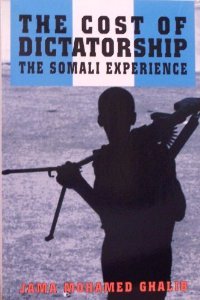By Ismail Warsame
Although I heard about it and reminded myself, on several occasions, to have a look at it, I, finally, had the opportunity to read Jama Mohamed Ghalib’s book, The Cost of Dictatorship, 1995 Edition. While I commend the author’s efforts to record his own experience with the extremely repressive regime he served loyally for such a long time, and although I am, perhaps, a bit sympathetic to his inclination to the Somali unity, I found the author’s account in the book full of historical distortions, perhaps with intended omissions of facts and extreme partiality towards forces that led to the removal of Siyad Barre military dictatorship.
 When I read Ghalib’s book I suddenly remembered one incident involving the author during the Somali National Reconciliation Conference in Imbagati, Kenya, 2002-2004. For whatever reasons Mr. Ghalib avoided Hargeisa even when it felt to the forces of Somali National Movement (SNM), he claims that he was the key man in Mogadishu at the time to support its armed struggle against Barre; the General remained connected to Mogadishu even after the collapse of the Somali State. Whatever role he played within the reign of Mogadishu Warlords and their struggle to finish one another, the General finally decided to act as an active member of the Mogadishu civil society politicized organizations. Because of external donors’ manipulations, these organizations became the most serious obstacle to the restoration and re-institution of the Somali state. One day in 2004 at the Safari Park Hotel, Nairobi, the President of Uganda, Yoweri Musaveni, in his capacity as the Current Chairman of IGAD, and in an effort to reconcile severely opposing views and differences within the Somali parties at the Conference, met with predominantly members of the Mogadishu civil societies. During the briefings and discussions with M7 (Musaveni), a lady from Digil and Mirifle group, named Ms. Ardo, who later became a member of the Somali Transitional Federal Parliament, complained to Musaveni that the “warlords are giving no chance to anyone, including a claim to be members of the civil societies like my brother General Jama Mohamed Ghalib”. Ghalib was comfortably sitting there when President Musaveni looked at Ghalib and asked him,” aren’t you a General? What are you doing here?”
When I read Ghalib’s book I suddenly remembered one incident involving the author during the Somali National Reconciliation Conference in Imbagati, Kenya, 2002-2004. For whatever reasons Mr. Ghalib avoided Hargeisa even when it felt to the forces of Somali National Movement (SNM), he claims that he was the key man in Mogadishu at the time to support its armed struggle against Barre; the General remained connected to Mogadishu even after the collapse of the Somali State. Whatever role he played within the reign of Mogadishu Warlords and their struggle to finish one another, the General finally decided to act as an active member of the Mogadishu civil society politicized organizations. Because of external donors’ manipulations, these organizations became the most serious obstacle to the restoration and re-institution of the Somali state. One day in 2004 at the Safari Park Hotel, Nairobi, the President of Uganda, Yoweri Musaveni, in his capacity as the Current Chairman of IGAD, and in an effort to reconcile severely opposing views and differences within the Somali parties at the Conference, met with predominantly members of the Mogadishu civil societies. During the briefings and discussions with M7 (Musaveni), a lady from Digil and Mirifle group, named Ms. Ardo, who later became a member of the Somali Transitional Federal Parliament, complained to Musaveni that the “warlords are giving no chance to anyone, including a claim to be members of the civil societies like my brother General Jama Mohamed Ghalib”. Ghalib was comfortably sitting there when President Musaveni looked at Ghalib and asked him,” aren’t you a General? What are you doing here?”
The point here is that General Ghalib can claim for himself any past societal status or role rightly or wrongly he so desires to be remembered of, but he cannot be allowed to distort modern history as we are all witnesses as well, and perhaps more informed than him with regards to the Somali movements established to fight against Barre Regime.
Let me set the record straight. The movements of SNM and USC that the esteemed General glorifies are nothing, but the work done by the Somali Salvation Democratic Front (SSDF) in its historical efforts to mobilize Somali masses against the military junta in Mogadishu. When some political leaders of prominently Issaks led by Mr Duqsi and Mr Jumcale, came to Addis Ababa, Ethiopia, and met with then leaders of the Somali Salvation Front (SSF), a successor of Somali Democratic Action Front (SODAF) in 1981, it was agreed to form a united front against the Regime. There was no SNM at that time. It was decided that Issaks had to organize themselves, either to join SSF individually and in groups, or to form their own movement with an intention to join forces later. The formation of SNM was announced in London, UK, in 1982 after SSF became SSDF with its merge with the Somali Communist Party led by Abdirahman Aidid, who was from Sool and Togdheer regions of Somalia, and Somali Workers’ Party led by Said Jama, hailing from North-western Somalia.
The SSDF sent a high level delegation composing of Mr. Jama Rabile Good (after he defected to SSDF) and Abdirahman Sugule Xaabsey to SNM leadership in London for unification talks. The SNM delegation led by the organization’s Secretary-General, Mr. Duqsi, came to meet with the SSDF leadership in Addis Ababa for unity talks. The talks continued for several weeks and ended in stalemate. The main reason for the failure of talks was the position of the SNM leaders that if they were to join with the SSDF, they might not secure the support of Issak masses as they were mostly bent to fighting against what they called southern domination. It was agreed that the SSDF, rich with Qadhafi money and huge and generous supply of modern arms, would bankroll the SNM and arm its forces for the next two years, or until the SNM could secure enough support from its own constituencies while the unity talks would continue in the foreseeable future. The SSDF shared its broadcasting radio studio, Radio Kulmis, and changed the name to Radio Halgan, the United Voice of the Somali Opposition. That cooperation continued through Sheikh Yusuf Madar/Issak/Habar-Awal until the SNM leadership of Col. Kosaar/Issak/Habar-Younis, who was assassinated, perhaps by Siyad Agents, in a Mustahiil (off Hiraan Region) SNM Military camp.
Ahmed Mohamed Silaanyo/Issak/Habar-Jeclo/Adan Madoobe was elected as Kosaar’s successor. The SSDF leadership ran into trouble with Mengistu Haile-Mariam. Then, the SSDF leader, Col Abdullahi Yusuf, was arrested by Mengistu because of serious political differences involving opposing national interests. There was a temporary lull in the activities of the SSDF. Then, the SSDF broke into two factions.
Jama Ghalib ignores the fact that the USC was a splinter group of the SSDF following the arrest of its leader in Ethiopia. The second and most influential figure in the USC leadership after General Aideed was the Late Mohamed Farah Jimcaale/Harbar-Gedir/Saad, a once Deputy Chairman of SSDF until General Aideed forced his way to remove Hussein Ali Shido/Harbar-Gedir/Suleiman with the support of Jimcaale at a militia camp at Somali – Ethiopian border. When General Aideed came to Ethiopia, in his initial attempt to remove Hussein Shido from the USC leadership, he was received by Mengistu. In that audience, Aideed requested for the release of Abdullahi Yusuf. Mengistu warned him not to try that again.
The trouble I have with Mr. Ghalib’s accounts is that he could know better, having a formal police and intelligence training–unless his intention is to distort facts—deny others of their historical role and glorify the works of yesterday’s political stooges of the hated regime. One should not stay with and serve a dictatorship for twenty-odd years, always in-waiting for an appointment to high office and higher promotion within the regime while claiming to be a staunch supporter of the opposition. You cannot be a police general and a member of the civil society at the same time!
In The Cost of the Dictatorship, Ghalib has no slightest fairness or guts to mention about the role of the first organized opposition to the Regime, The SSDF. Read and see his tendency towards not mentioning even once the name of its leader, Abdullahi Yusuf Ahmed, while he glories the names and noble contributions of his colleagues, including himself, in the Regime of Siyad Barre. He is easily exposed, however, when he ignores the fact regarding the SNM that an organization does not fight for liberation and independence while at the same time installing yesterday’s political stooges and security agents of the dictatorship as its new leaders. It makes no sense.
I, therefore, strongly believe that there are many distortions and twisting of facts in Ghalib’s book, The Cost of Dictatorship. Some stories recounted in the book must be re-examined and verified as its author seems emotionally partial, accompanied with a motive, I suspect, to deny his role and responsibilities in the gross misconduct of Somalia’s affairs, horrendous abuses of power and human rights violations during the period the author served not his country, but Siyad Barre’s junta.
Having said that, I am, however, a bit inclined to agree with General Ghalib’s overall assessment of the extent and the irreversible damages Issak intellectuals had done to undermine the existence and vital national interests of Somalia’s state in their blind fight against Siyad Barre Regime or the “southern domination”. In that regard, I recall one painful expression or rather a question relayed to me in a conversation in Nairobi, Kenya, a few years ago, with Mr Mohamud Jama “Sifir”, a longtime employee of the UN about the extra efforts of these intellectuals have been exerting in destroying Somalia as we knew it: “Who will ever dig Somalia out of the deep hole of our own making?” Sifir told me that the question was raised by one of his colleagues as they assessed the tremendous damages done not only to Siyad Barre Regime, but to Somalia to a much greater extent, during their anti-regime campaigns in foreign and Western capitals within the international community. No wonder Somalia becomes too difficult to fix.
Ismail Warsame
WardheerNews contributor
Email:[email protected]
We welcome the submission of all articles for possible publication on WardheerNews.com. WardheerNews will only consider articles sent exclusively. Please email your article today . Opinions expressed in this article are those of the author and do not necessarily reflect the views of WardheerNews.
WardheerNew’s tolerance platform is engaging with diversity of opinion, political ideology and self-expression. Tolerance is a necessary ingredient for creativity and civility.Tolerance fuels tenacity and audacity.
WardheerNews waxay tixgelin gaara siinaysaa maqaaladaha sida gaarka ah loogu soo diro ee aan lagu daabicin goobo kale. Maqaalkani wuxuu ka turjumayaa aragtida Qoraaga loomana fasiran karo tan WardheerNews.
Copyright © 2024 WardheerNews, All rights reserved


